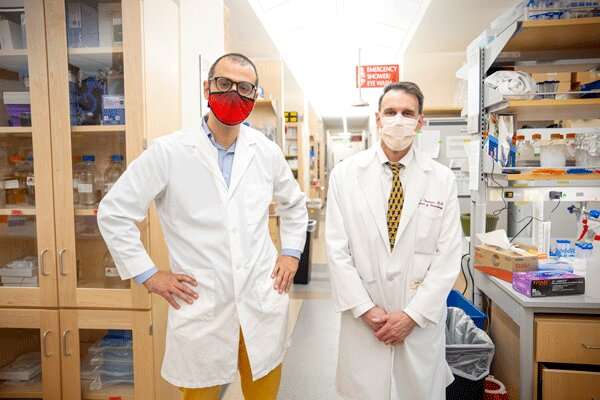Benjamin Sanchez-Terrones, PhD | Doug Grossman, MD, PhD. Credit: Huntsman Cancer Institute
In the United States alone, about 3.3 million people are diagnosed with basal and squamous cell cancers (skin cancers) per year. Skin cancer is still detected using visual examination, a method of limited reliability for early detection, subtype determination, or measuring the extent of skin invasion. Researchers at Huntsman Cancer Institute (HCI) and the University of Utah (U of U) have created a device, named URSKIN, that exploits changes in the electrical properties of skin that occur during cancer cell development by using a technique called non-visual electrical impedance demography (EID).
EID measures the opposition of electrical current related to skin cancer specifically.
"URSKIN applies a high-frequency, painless electrical current through the skin of interest," says Benjamin Sanchez-Terrones, Ph.D., cancer center member at HCI and assistant professor of electrical and computer engineering at the U of U. "Physiological alterations in cancerous skin tissue then generate a unique voltage signature that is different from clinically normal skin."
Led by Sanchez-Terrones and Doug Grossman, MD, Ph.D., physician scientist at HCI and professor of dermatology at the U of U, the pilot study tested the new device on 18 patients who already had biopsy-confirmed basal cell carcinoma, the most common form of skin cancer.
"Clinical presentation of basal cell carcinoma can be subtle," says Grossman. "It would be useful to have a non-invasive device to detect basal cell carcinoma at its earliest stage and also to be able to determine the depth of invasion to guide whether a biopsy should be performed and what type of biopsy is needed to fully assess the tumor."
Four different EID measurements were taken on each patient to assess the electrical properties of the basal cell carcinoma and the normal skin around it. URSKIN was able to detect significant differences between basal cell carcinoma and the healthy skin next to it. The next steps for the device are to study more basal cell carcinoma patients to determine how well the device can distinguish between subtypes and to investigate its ability to identify other skin cancers, such as squamous cell carcinoma.
"Compared to visual examination, URSKIN is low-cost, easily applied, quantitative, and objective, enabling the measurements of standardized electrical values of the skin," says Sanchez-Terrones. "This newly gathered information from a measurement can be leveraged to increase physicians' confidence and help overcome current diagnostic hurdles."
Provided by Huntsman Cancer Institute






















